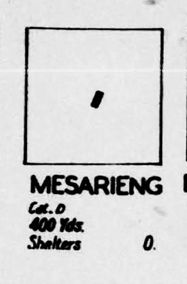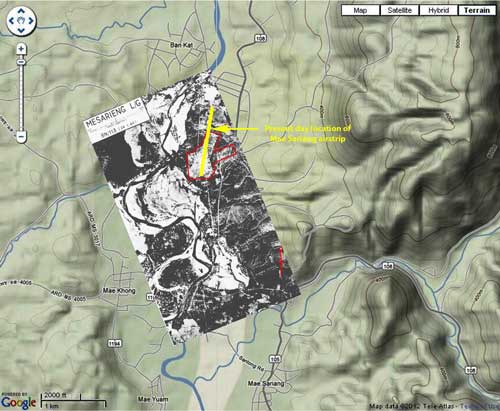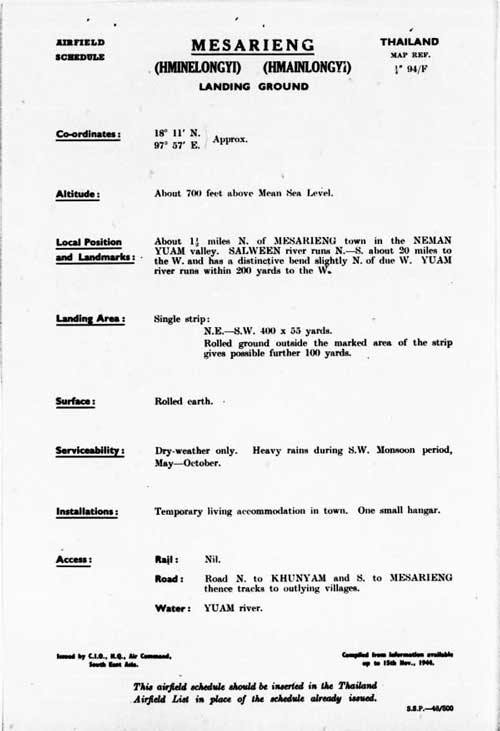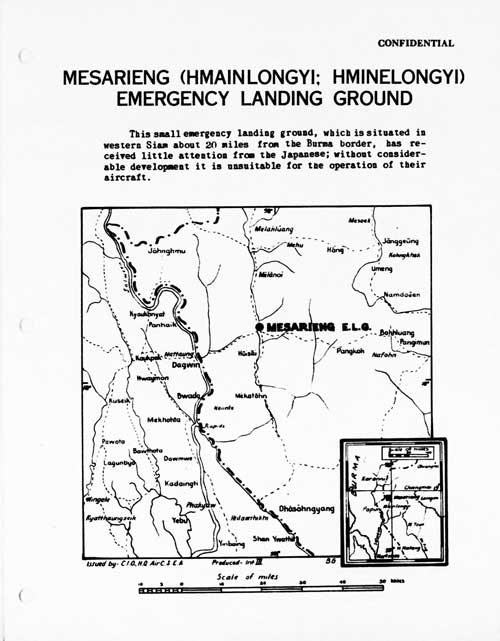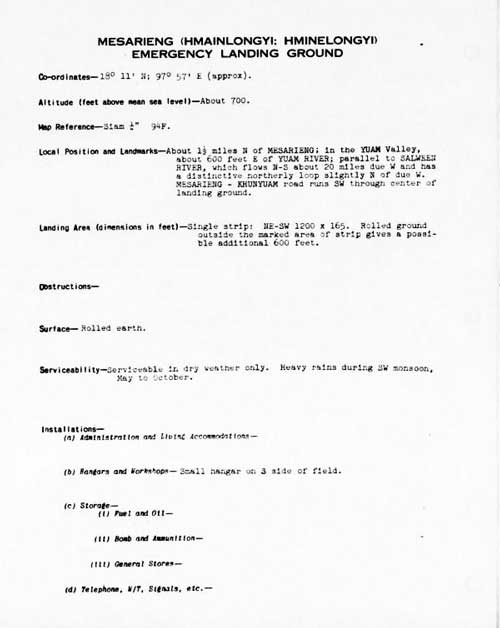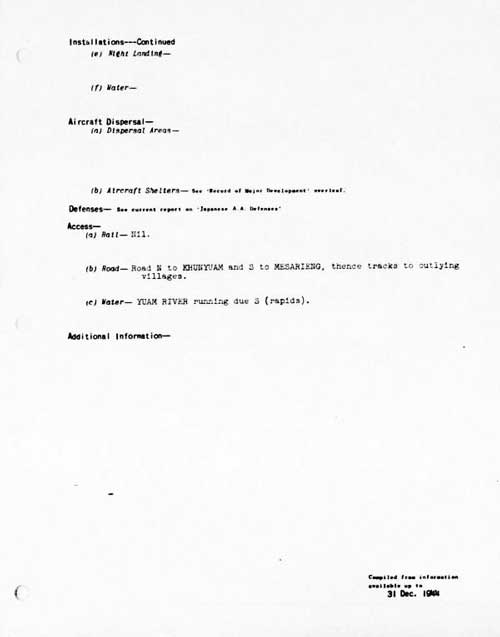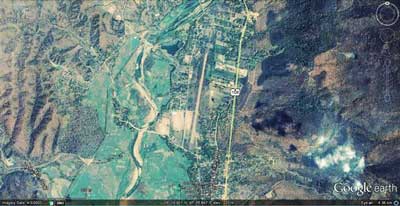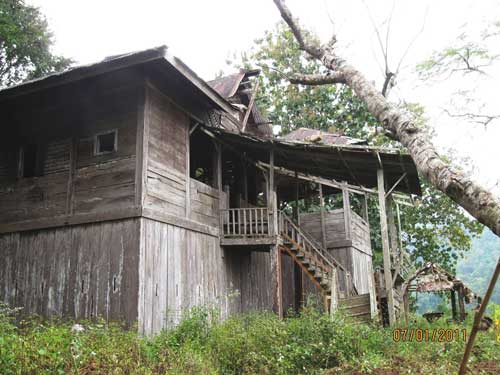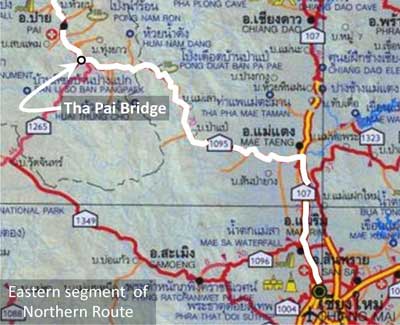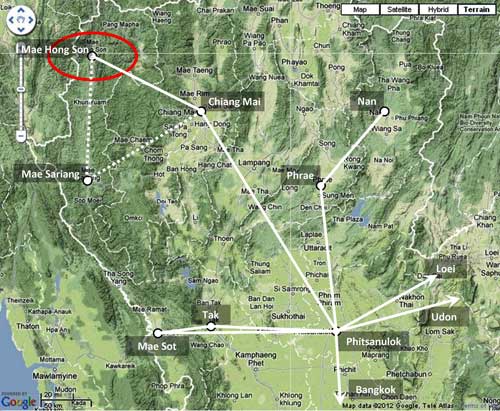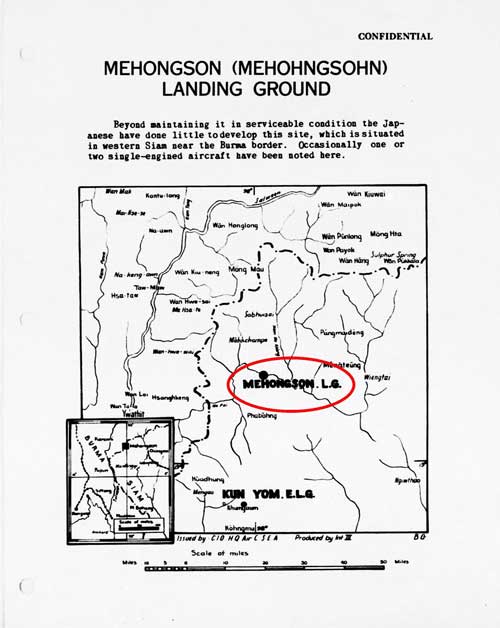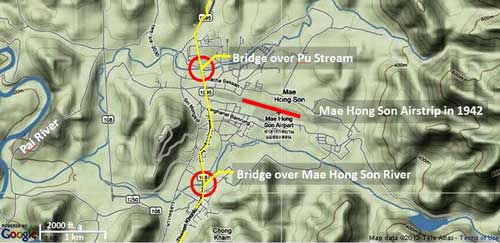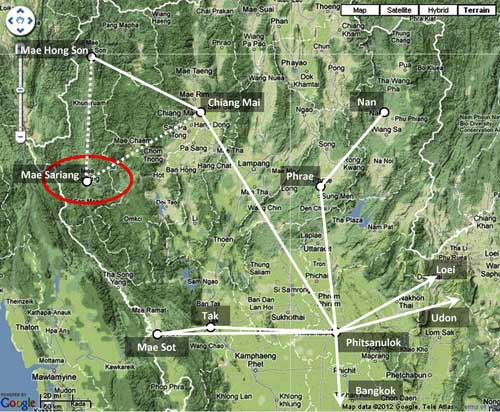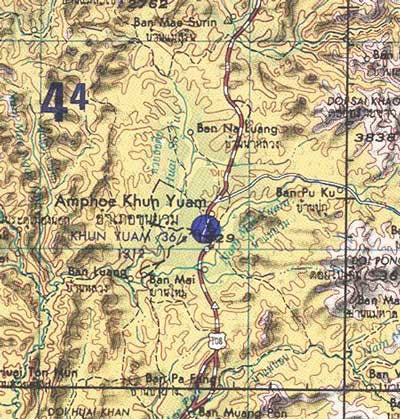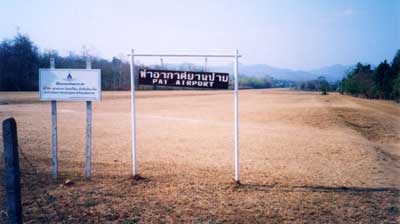Activities during the war
04-30 January 1942
The Kong Bin Noi Phasom (Combined Wing) 80, newly stationed at Chiang Rai,1 sent Vought Corsairs and Curtiss Hawk IIIs from Squadrons 22 and 41 to scout and bomb the enemy in various locations in Burma and to patrol the skies over Mae Chaem, Mae Sariang, Khun Yuam, and Mae Hong Son.2
07 January 1942
Sgt Pilot Victor Bargh, a New Zealander, in Royal Air Force (RAF) 67 Squadron, flew a photo-reconnaissance mission from Mingaladon, over Mae Sariang.3
21-22 January 1942
[RAF 113 Squadron] Blenheims bombed Raheng and Mesarieng on the 21st and 22nd, dropping 6,000 lb of bombs on each target.4
28 February 1942
The Indian Air Force (IAF) made a surprise strafing attack on Mae Sariang.5
January 1944
Allied intelligence issued a so-called “airfield miniature” of Mesarieng airstrip:6
“Cat D” (Category D) refers to “Fair weather only”.
“400 Yds” (437 m) can fit with the 1944 overlay.
January 1944
An early amendment to an Allied intelligence report:7
Transcription
MESARIENG: Under Remarks delete: “but has been possibly extended to accommodate military aircraft.”
Note: the sheet to which this applies is not available.
January 1944
This aerial photo, taken in January, was only published in the April 1944 issue of Airfield Report. While not of raw aerial photo clarlity, this image, scanned by Sakpinit Promthep from the original Airfield Report, is a vast improvement over the version previously used here which was a microfilm copy:8
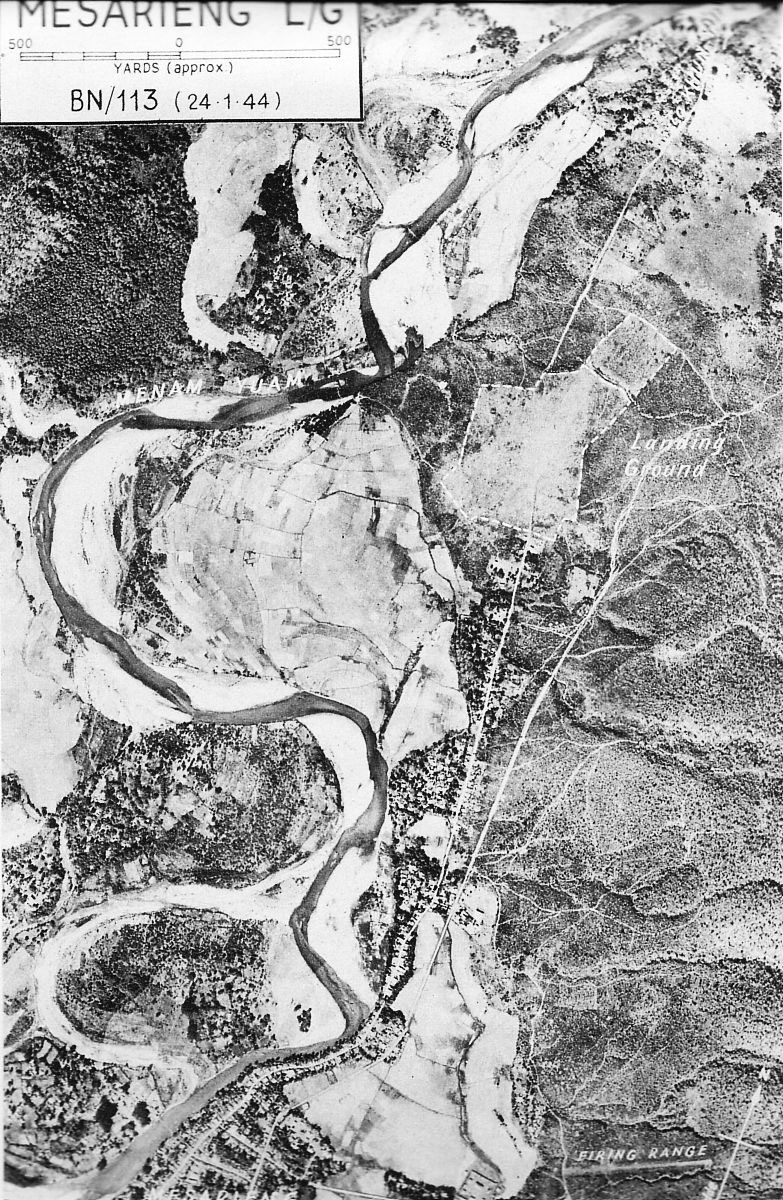
Note that the north arrow in the lower right corner of the photo does not point directly up the page. Placed on a modern map shows its proper orientation and is the basis for the location map on page 1 of this article9
February 1944
An Allied intelligence report noted no activity:10
April 1944
The earliest formal Allied intelligence report currently available:11
Transcription:
MESARIENG (HMINELONGYI) (HMAINLONGYI) Landing Ground
¼-inch Map Ref Sheet 94F
Coordinates: N18°11 E97°57 (approx.)
Local Position: In the MENAM YUAM Valley about 1½ miles north of town
Altitude: About 700 feet above MSL
Landing Area: Approx 400 x 400 yards with clearing at the
northeast corner giving a max run of 600 yards in a
NNE-SSW direction.
Surface: Cleared scrub.
Serviceability: Liable to become unserviceable after heavy rains.
Installations: One small hangar.
Communications: Rail: No rail available.
Road: Road north to KHUNYAM and south to MESARIENG
thence track to outlying villages.
River: YUAM running due south has rapids.
Landmarks: SALWEEN River runs north to south about
20 miles to the west and has a distinctive bend
slightly north of due west. The Landing Ground lies
in a valley running parallel to SALWEEN Valley. YUAM
River within 200 yards west of the site.
Compiled from information available up to 30 Apr 44.
Another section of that report in April 1944 made an observation significant for the entire history of the Mae Sariang airstrip during WWII:12
Transcription:
It is interesting to note that the meagre line of landing grounds in close proximity to the Burmese border from Mae Hong Son to Mae Sot, including Khun Yuam and Mae Sariang, have not to date been developed. In view of their difficult lines of communication it is unlikely however, that they would be employed for any purpose other than emergency use so that some form of maintenance work is likely to be the limit of their attention.
July 1944
The airstrip with some detail was included in an Allied intelligence listing of airports:13
Transcription:
Name: Mesarieng (N18 E101)
Group: ELG [Emergency Landing Ground]
Position: N18°11 E97°56
Altitude: 700 feet
Location: 1½ miles north of Mesarieng, on east bank of
Yuam River and west side of Mesarieng-Dha Khom
Road;19¾ miles east of Salween River.
Dimensions: Maximum run: 1800 feet NNE/SSW
Description: Cleared scrub; liable to be u/s [unserviceable]
after heavy rains (Apr 44)
November 1944
Another Allied intelligence formal report on the Mae Sariang airstrip:14
Transcription:
MESARIENG (HMINELONGYI) (HMAINLONGYI) Landing Ground
¼-inch Map Ref Sheet 94/F
Coordinates: N18°11 E97°57 (approx.)
Altitude: About 700 feet above MSL
Local Positions and Landmarks: About 1½ miles north of
Mesarieng town in the NEMAN YUAM valley. SALWEEN
river runs north-south about 20 miles to the west
and has a distinctive bend slightly north of due west.
Yuam River runs within 200 years to the west. YUAM
River within 200 yards west of the site.
Landing Area: Single strip:
Northeast-southwest 400 x 55 yards
Rolled ground outside the marked area of the strip
gives possible further 100 yards.
Surface: Rolled earth.
Serviceability: Dry-weather only. Heavy rains during
southwest monsoon period, May-October.
Installations: Temporary living accommodation in town.
One small hangar.
Access:
Rail: Nil
Road: Road north to KHUNYAM and south to
MESARIENG thence tracks to outlying villages.
River: YUAM running due south has rapids.
Compiled from information available up to 15 Nov 44.
31 December 1944
The last formal Allied intelligence report on the Mae Sariang airstrip:15
Transcription
“This small emergency landing ground, which is situated in western Siam about 20 miles from the Burma border, has received little attention from the Japanese; without considerable development it is unsuitable for the operation of their aircraft.”
The more familiar Allied intelligence report format:16
Transcription:
MESARIENG (HMAINLONGYI; HMINELONGYI)
EMERGENCY LANDING GROUND
Co-ordinates — N18°11 E97°57 (approx.)
Altitude (feet above MSL) — about 700
Map Reference — Siam ¼” 94F
Local Position and Landmarks — About 1 ½ miles north of
MESARIENG; in the YUAM Valley, about 600 feet east
of YUAM RIVER; parallel to SALWEEN RIVER, which
flows N-S about 20 miles due west and has a
distinctive northerly loop slightly north of due west.
MESARIENG-KHUNYUAM road runs southwest through
center of landing ground.
Landing Area (dimensions in feet) — Single strip: NE-SW
1200 x 165. Rolled ground outside the marked area
of strip gives a possible additional 600 feet.
Obstructions — [blank]
Surface — Rolled earth
Serviceability — Serviceable in dry weather only. Heavy
rains during southwest monsoon May to October.
Installations —
(a) Administration and Living Accommodations —
(b) Hangars and Workshops — Small hangar on
three side of field.
(c) Storage —
(i) Fuel and Oil —
(ii) Bomb and Ammunition —
(iii) General Stores —
(d) Telephone, W/T, Signals, etc —
(e) Night Landing —
(f) Water —
Aircraft Dispersal —
(a) Dispersal Areas —
(b) Aircraft Shelters — [deadend reference]
Defenses —
see current report on ‘Japanese AA Defenses’
Access —
(a) Rail — Nil
(b) Road — Road N to KHUNYUAM and S to
MESARIENG, thence tracks to outlying villages.
(c) Water — YUAM RIVER running due S (rapids).
Compiled from information available up to 31 Dec 1944.
05 March 1945
According to Mr Porm Sootsukon (a civil servant in Mae Hong Son) around 1235 hours on 05 Mar 1945, a single two-engined Allied Forces plane from the direction of Burma flew over the Mae Sariang governor’s official resident and then went on . . . . It was assumed that the intent . . . was just psychological in support of the Free Thai movement.17
20 March 1945
“. . . the fighter squadrons of the 2nd Air Commando Group flew to northern Thailand to strafe fields at Chiengmai and [Phrae]18 , which were being used by the Japanese as air staging posts. Near Chiengmai Capt William C Marshall of the 1st Command Squadron encountered a small single-engined aircraft which he identified as a ‘Stinson-type’ and shot it down. It was in fact a civilian Fairchild 24 of the Aerial Transport Company of Thailand,19 which was unfortunate enough to have arrived at exactly the same time as the US fighters.”20
20 March 1945(?)
The pilot who flew the Norseman regularly from Chiang Mai to Mae Hong Son before the war, was a Mr Puai. Local people called the aircraft “Mr Puai’s aircraft”.
During the war, Mr Puai was shot down by an Allied aircraft while flying to Mae Sariang. The company and local people as well as his family were saddened to lose a good and friendly pilot.21
20 March 1945(?): another version, badly garbled
Interviewee No. 8, Mr Boon-ton Sriwichai:
After [?] the war, there was a Thai mail plane (for letter delivery from Mae Hong Son to Amphoes Khun Yuam and Mae Sariang). This plane flew three times a month. One day this mail plane encountered British aircraft flying in the opposite direction. The British pilots saw the Thai pilot and mistook him for a Japanese. Later the mail plane encountered 40 – 50 British planes, two of which turned and attacked. The mail plane caught fire and crashed in the Ban Mae Surin area.
Villagers went to see the plane crash site and found four dead bodies. They included the pilot, Mr. Pui (surname unknown); a pilot assistant (name unknown); a Japanese soldier in uniform; and the superintendent of Mae Hong Son. The next day, the bodies were ceremonially cremated. The remains of the Japanese soldier were taken to Japan. There were some burnt banknotes (about 10,000 baht), two pistols, and other belongings in the crashed plane which district officers took.22
April 1945
Amendments to Airfield Lists: SIAM: Amendment List No. 1 (1945):23
Transcription:
MESARIENG L/G: Landing Area: Amend to read:
Single strip: NE-SW, 1000 x 55 yards approx.
Apparently this item amends the report dated 31 December 1944 above.
??? 1945
. . . [apparently in late 1945] seven planes, guns firing, dropped
24 bombs, which fell in arice field behind Mae Sariang City Hall.
Four failed to explode. Nobody died.24
Through 15 August 1945 (end of war)
For record purposes, as of July 2012, good quality World War II era aerial photographs of the Mae Sariang area have not been found.
1977
View of the condition of the airstrip by a member of the 1977 Japanese team searching for I J A remains:
. . . on the eastern side of the “airfield.” I say “airfield”: it is only a narrow field where the red clay is raked and flattened. All around seems to be a second-growth forest of teak; weeds and bushes are grown out to about one or two meters.25
1990
The movie, Air America, was released in 1990; it had used the airstrip at Mae Sariang in some of its scenes.26
1992 / 2007(?)
Royal Thai Survey Department Map No. 4545 II, Title: Mae Sariang:
7017 Series (Mar 1992): information is out-of-date
7018 Series ( 2007 ?): this is the current series and is
controlled by copyright.
03 April 2003:
Google Earth view of Mae Sariang airstrip area27
AIRPORT CURRENT STATS28
Name: Mae Sariang Airport – VTCS4
Coordinates: N18°11.3 E97°55.7
Runway Heading: 01/19
Length: 1,000 meters
Slope: none
Elevation: 750′
Obstructions: Clear.
The Thai Flying Club webpage for Mae Sariang Airport features two excellent oblique photos of the site; unfortunately, directions of photo views are less than clear: the smaller oblique photo (bottom left) dated 2003 looks south per Club comment; but the larger oblique dated 2007 looks north (note that the near end of the runway is labeled “01”). The webpage incorrectly identifies the river just to the west as the Salween; in actual fact, it is the Yuam. The Salween is about 27 km west.
The Thai Flying Club’s two oblique photos of the runway also demonstrate that it was paved sometime between 2003 and 2007.
| First published on Internet | ||
| Added many page images; tried to standardize style; smoothed. | ||
| Substituted improved aerial photo from Airfield Report. | ||
- Young, ibid, p 185. [↩]
- บระวัติกองทัพอากาศไทย พ.ศ.๒๔๕๖ ๒๕๒๖ กองทัพอากาศ พุทธศักราช ๒๕๒๖, [History of the Thai Air Force, 1913-1983 (Bangkok: Royal Thai Air Force, 1983)], p 308. [↩]
- Frances, Neil, Ketchil (Masterson NZ: Wairarapa Archive, 2005), p 68. [My ref: Aerial N186]. [↩]
- Shores, Christopher & Brian Cull, with Yasuho Izawa, Bloody Shambles vol I (London: Grub Street, 2007), p 260 [My ref: BSI:07 260, 21-22 Jan 42]. Also Young, ibid, p 186 [My ref: Aerial N 186]. Corroborated by Pearson, Michael, The Burma Air Campaign 1941-1945 (South Yorkshire: Pen & Sword, 2006), pp 33‑34. [↩]
- Information from The Official History of the RIAF per Jagan Pillarisetti email of 29 Jun 2008 00:11. [↩]
- Airfield Report No. 18, Jan 1944, Airfield Miniatures, unnumbered page (USAF Archive microfilm reel A8055 p 422). [↩]
- Airfield Report No. 18, Jan 1944, p 37 (USAF Archive microfilm reel A8055 p 476). [↩]
- Airfield Report No. 21, Apr 1944, unnumbered page: scan provided by Sakpinit Promthep by email of 10:26 15 Oct 2021 (previous version of lesser quality was from USAF Archive microfilm reel A8055 p 646). [Added 22 Oct 2021]. [↩]
- Aerial photo above overlaid on a “Terrain map” from Nations Online Project: Searchable Map and Satellite View of Thailand using Google Earth Data (accessed 20 May 2012). Matching and annotations by author using Microsoft Publisher. [↩]
- Airfield Report No. 19, Feb 1944, p 24 (USAF Archive microfilm reel A8055 p 524). [↩]
- Airfield Report No. 21, Apr 1944, no page number (USAF Archive microfilm reel A8055 p 671). [↩]
- ibid, p 4, “Review of Airfield Development in Thailand”, (USAF Archive microfilm reel A8055 p 618). [↩]
- Provisional Airfield List, Report No. 3, 25 Jul 1944, p 63 (USAF Archive microfilm reel A1284 p 1413). [↩]
- Airfield Report No. 28, Nov 1944, unnumbered page (USAF Archive microfilm reel A8055 p 1080). [↩]
- Siam (Thailand) List of Airfields and Seaplane Stations (Washington: Ass’t Chief of Air Staff, Intelligence, 1945), unnumbered page (USAF Archive microfilm reel A1285 p 1241). [↩]
- ibid, unnumbered pages (USAF Archive microfilm reel A1285 pp 1242, 1243). [↩]
- รายงาน การ สําร จอขุดค้น – ตาม โครงการ คึกษาเชิงอนรักษ์แหล่ง ฝังศพทหารญี่บุน-สมัย สงครามโลกครั้งที่ 2 จังหวัดแม่ฮ่องสอน – หัางหุ้นส่วนจํากัดเฌอ กรีน – เสนอต่อ – จังหวัดแม่ฮ่องสอน – สำนักงานโบราณคดีและพิพิธภณฑสถาน แห่งชาติที่6 ใชียงเหม่ (1999) Report on Archaeological Research for the Japanese Soldiers Burial Project World War II Era – Mae Hong Son Province (Chiang Mai: Green Tree, LLP, Ltd, submitted by / for Mae Hong Son Province Archaeology & National Museum Office 6, Chiang Mai, 1999), p 117. Hereafter: Report on Archaeological Research. [↩]
- Shore identified Phroe: that name does not appear on Thai maps. Similar in name in the area were Phrao, Phayao, and Phrae. Only the last had an air facility (N18°08 E100°10), 60 km ESE of Lampang and shown on US Army Series L509, NE 47-7 “Lampang”. [↩]
- “Stinson-type” aircraft: the Stinson SR-series was popular before the war per Wikipedia’s Stinson Reliant, but that reference does not list any models in Thailand.
Mentioned in a following version: The Noorduyn Norseman. “. . . it looked surprisingly like the Stinson SR 10.” per RCGroups.com‘s Noorduyn U-64 Norseman.
However, “Until 1940, the Noorduyn company had sold only 17 aircraft in total, primarily to commercial operators in Canada’s north and to the Royal Canadian Mounted Police.” per Wikipedia‘s Noorduyn Norseman.
On the other hand, Thai Aviation Net‘s Thai Civil Register and Royal Thai Air Force listing record no Norseman or Stinson models registered before the war; but the civil register does record a Fairchild 24 exported to Thailand 04 Oct 1940 (that particular aircraft survived at least until 1955) and its Air Accidents list records a Thai Air Force Fairchild 24 shot down in Mar 1945 by a USAAF P-51.
It would appear that the aircraft could only have been a Fairchild 24 as Shores asserts. [↩]
- Quoted from Shores, Christopher, Air War for Burma [“The Third . . . Volume of the Bloody Shambles Series”] (London: Grub Street, 2005), p 342. [↩]
- บุญเสิม สาตราภัย เชียงใหม่กับภัยทางอากาศ (กรุงเทพฯ: วิญฌูชน, 2003) Boonserm Satrabhaya, Chiang Mai and the Air War (Bangkok: Winyuchon, 2003), p 136. No date for incident was provided. [↩]
- เชิดชาย ชมธวัช, บ้อมูลเส้นทางเดินทัพทห
ารญี่ปุ่น ในอำเภอบุนยวม สงครามมหาเอเชียบูรพา (สงครามโลกครั้งที2) จดทำโดย พันตำรวจโท
Chomtawat, Cherdchay, Information about Japanese soldiers traveling through Amphur Khun Yuam in World War 2 [15 Interviews] (self published, undated, but before 2004), unnumbered page.This is the only version to mention the crash site as Mae Surin. There are other stories about a crashsite there. See Mae Surin. (link to lanna-ww2 page unknown. [↩]
- Airfield Report No. 33, Apr 1945, p 11 (USAF Archive microfilm reel A8056 p 174). [↩]
- Report on Archaeological Research, p 109 [My ref: CMMR 109]. [↩]
- Journal, p 455. [↩]
- Thai Flying Club – Mae Sariang Airport. [↩]
- Google Earth view of Mae Sariang airstrip area, image data dated 03 Apr 2003; accessed 30 Apr 2012. [↩]
- Thai Flying Club: ibid. [↩]
